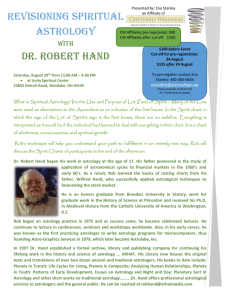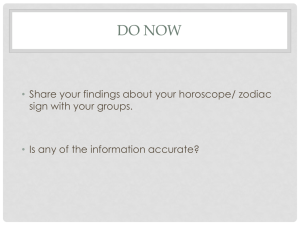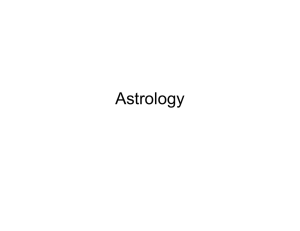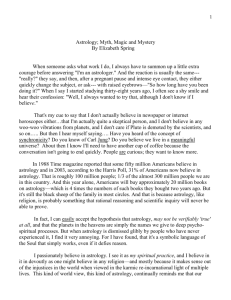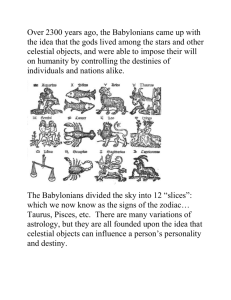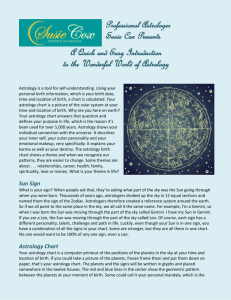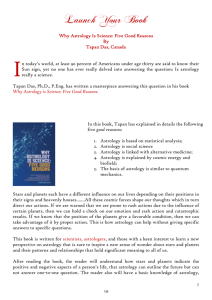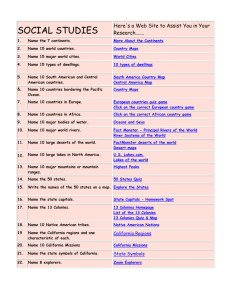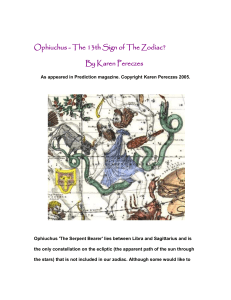Activities about Astrology
advertisement
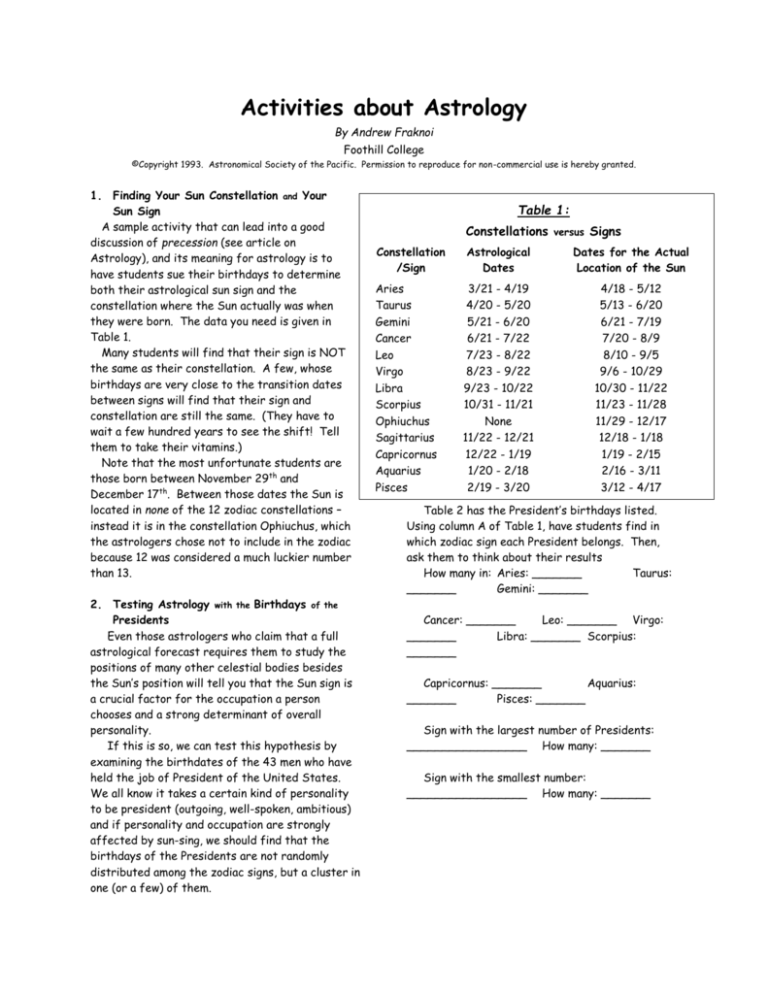
Activities about Astrology By Andrew Fraknoi Foothill College ©Copyright 1993. Astronomical Society of the Pacific. Permission to reproduce for non-commercial use is hereby granted. 1. Finding Your Sun Constellation and Your Sun Sign A sample activity that can lead into a good discussion of precession (see article on Astrology), and its meaning for astrology is to have students sue their birthdays to determine both their astrological sun sign and the constellation where the Sun actually was when they were born. The data you need is given in Table 1. Many students will find that their sign is NOT the same as their constellation. A few, whose birthdays are very close to the transition dates between signs will find that their sign and constellation are still the same. (They have to wait a few hundred years to see the shift! Tell them to take their vitamins.) Note that the most unfortunate students are those born between November 29th and December 17th. Between those dates the Sun is located in none of the 12 zodiac constellations – instead it is in the constellation Ophiuchus, which the astrologers chose not to include in the zodiac because 12 was considered a much luckier number than 13. 2. Testing Astrology with the Birthdays of the Presidents Even those astrologers who claim that a full astrological forecast requires them to study the positions of many other celestial bodies besides the Sun’s position will tell you that the Sun sign is a crucial factor for the occupation a person chooses and a strong determinant of overall personality. If this is so, we can test this hypothesis by examining the birthdates of the 43 men who have held the job of President of the United States. We all know it takes a certain kind of personality to be president (outgoing, well-spoken, ambitious) and if personality and occupation are strongly affected by sun-sing, we should find that the birthdays of the Presidents are not randomly distributed among the zodiac signs, but a cluster in one (or a few) of them. Table 1: Constellations versus Signs Constellation /Sign Aries Taurus Gemini Cancer Leo Virgo Libra Scorpius Ophiuchus Sagittarius Capricornus Aquarius Pisces Astrological Dates Dates for the Actual Location of the Sun 3/21 - 4/19 4/20 - 5/20 5/21 - 6/20 6/21 - 7/22 7/23 - 8/22 8/23 - 9/22 9/23 - 10/22 10/31 - 11/21 None 11/22 - 12/21 12/22 - 1/19 1/20 - 2/18 2/19 - 3/20 4/18 - 5/12 5/13 - 6/20 6/21 - 7/19 7/20 - 8/9 8/10 - 9/5 9/6 - 10/29 10/30 - 11/22 11/23 - 11/28 11/29 - 12/17 12/18 - 1/18 1/19 - 2/15 2/16 - 3/11 3/12 - 4/17 Table 2 has the President’s birthdays listed. Using column A of Table 1, have students find in which zodiac sign each President belongs. Then, ask them to think about their results How many in: Aries: _______ Taurus: _______ Gemini: _______ Cancer: _______ Leo: _______ Virgo: _______ Libra: _______ Scorpius: _______ Capricornus: _______ Aquarius: _______ Pisces: _______ Sign with the largest number of Presidents: _________________ How many: _______ Sign with the smallest number: _________________ How many: _______ Table 2: Birthdays of the Presidents George Washington John Adams Thomas Jefferson James Madison James Monroe John Quincy Adams Andrew Jackson Martin Van Buren William Henry Harrison John Tyler James K. Polk Zachary Taylor Millard Fillmore Feb 22, 1732 Oct 30, 1735 Apr 13, 1743 Mar 16, 1751 Apr 28, 1758 July 11, 1767 Mar 15, 1767 Dec 5, 1782 Feb 9, 1773 Mar 29, 1790 Nov 2, 1795 Nov 24, 1784 Jan 7, 1800 Grover Cleveland Benjamin Harrison William McKinley Theodore Roosevelt William Howard Taft Woodrow Wilson Warren G. Harding Calvin Coolidge Herbert Hoover Franklin Roosevelt Harry S. Truman Dwight Eisenhower John F. Kennedy Mar 18, 1837 Aug 20, 1833 Jan 29, 1843 Oct 27, 1858 Sep 15, 1857 Dec 28, 1856 Nov 2, 1865 July 4, 1872 Aug 10, 1874 Jan 30, 1882 May 8, 1884 Oct 14, 1890 May 29, 1917 Franklin Pierce James Buchanan Abraham Lincoln Andrew Johnson Ulysses S. Grant Rutherford B. Hayes James A. Garfield Chester Arthur Nov 23, 1804 Apr 23, 1791 Feb 12, 1809 Dec 29, 1808 Apr 27, 1822 Oct 4, 1822 Nov 19, 1831 Oct 5, 1829 Lyndon B. Johnson Richard Nixon Gerald Ford Jimmy Carter Ronald Reagan George Bush Bill Clinton George W. Bush Barack Obama Aug. 27, 1908 Jan. 9, 1913 July 1, 1913 Oct. 1, 1924 Feb. 6, 1911 June 12, 1924 Aug. 19, 1924 July 6, 1946 Aug. 4, 1961 3. Horoscopes from Different Astrologers If your students are old enough, ask them to bring in newspapers with astrology columns for a given day from as large a number of cities as possible. Otherwise, you may need to purchase the newspapers yourself. It’s very important (for psychological impact) that the newspaper be taken apart and any horoscopes cut out in full view of the students. Assign ach newspaper to a group of students and then ask one member of each group to read aloud the horoscope of a selected student (this could be someone who got the highest or lowest grade on the last science exam, for example. How well do the predictions of different astrologer agree for that student’s sign. Have the students discuss the reasons for the discrepancies. (How specific are the newspaper statement? Could they apply to a lot of different people?) If we are considering 43 presidents, and they were randomly distributed among the 12 signs of the zodiac, how many would you expect in each sign: _______ (average # expected per sign) From this test, would you say the birth dates of the Presidents are strongly clustered in one or a few signs? _________________ 4. Mixed-up Horoscopes Get a newspaper for a recent day (yesterday or the past weekend) that features an astrology column. (It’s best to use a paper with an astrology column that your students would not normally see, so they are not likely to have read the horoscopes.) Make a copy of the full column for yourself and put it aside. Then cut off the dates and signs from each description on the original, and delete or cover up any telltale references to the sign like, “you’re a real lion at times.” Mix up the descriptions, and give each one a number from 1 to 12. Transfer these numbers to your copy for future reference. Distribute the number (but otherwise unlabeled) paragraphs to the students. Each student should write his/her name and birthday on the sheet and then select and circle the one description that best fits the day in question. (Be sure you remind them of the day the horoscopes apply to – e.g. yesterday or this past Saturday.) Ask students to predict how this experiment will turnout. (Provided everyone remembers the day in question clearly and assuming sun-sign astrology predicts one’s day pretty well, students should in general be able to find their own paragraph. But if chance instead of the stars governs the composition of those descriptions, we would expect that only one out of 2 of the students would have selected the description for their own signs.) To prevent sudden changes of answers, some people like to ask students to exchange papers at this point. Then, you can put the signs and birthdates associated with each numbered paragraph on the board and ask students to tally the number of matches. Have them discuss the results. WARNING: With the small numbers of students in one class, it often happens by chance that there are a few more “hits” than one would expect. If students get intrigued by such extra hits, one way to check is to extend the test to other students or school staff. This resource is part of Project ASTRO, a program to enhance science education through partnerships between teachers and astronomers. Sponsored by the Astronomic Society of the Pacific (ASP), the project is funded by a grant from the National Science Foundation. For more information or the right to reproduce this material, write: Project ASTRO, ASP, 390 Ashton Ave., San Francisco, CA 94112 or call 415.337.1100; https://www.astrosociety.org/education/k12-educators/project-astro/
